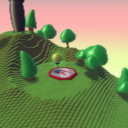Home/Resources/Open Ended Developer Experience, part 1
Open Ended Developer Experience, part 1


- Lesson plan 6: Open Ended Developer Experience, part 1
- Slides for lesson 6 and PowerPoint source
- Student Ages: 9-14 years old
- Activity Time: 45-60 minutes
- Activity Level: Beginner Coder
Prerequisites
- Download and Installation of Kodu
- Lesson 1: Managed Test Drive
- Lesson 2: Guided Investigation
- Lesson 3: Exploring Developer Experience, part 1
- Lesson 4: Exploring Developer Experience, part 2
- Lesson 5: Creative Collaboration
Learning Objectives
- Share draft version with the class
- Assess plan revision ideas
- Collaborate to create a game from plans
- Gather and assess feedback
- Seek peer experts
- Revise game
Contents
- Lesson plan 6: Open Ended Developer Experience, part 1
- Slides for lesson 6 and PowerPoint source
- Lesson 6: Print Student Guide:
- Open-ended Developer Experience, part 1 (1 per student)
- Lesson 6: Present Teacher Resources:
Student Activities
Getting Started: Big Question Review
Introduce with Big Questions for this lesson on Slide 2.
Subjects: Computer Science, Design Technology, Digital Literacy, 21st Century Learning Skills
Show and Tell
Direct students to page 21 of the Student Workbook: First Draft Show and Tell. The teacher could refer to the guided writing prompts Slide 3. The teacher should model how to “show and tell” their games using Fishbots Plus Students should be shown how to open their game, use the projector to display their game; show how the game works; tell students about the game; follow the four prompts using the Activity checklist: “Show and Tell”. The teacher will support students with the Show and Tell presentations by keeping the time within two minutes; call a stop, and time for feedback; lead students to provide feedback using the Wows, Wonders, and Wants feedback strategy. Continue the loop until all teams have presented their games and have received feedback. Students listing to a presentation will complete the feedback using the Student Guide: Activity “Wows, Wonders, and Wants”
Subjects: Computer Science, Design Technology, Digital Literacy, 21st Century Learning Skills
Assessing Feedback
After all of the presentations, instruct teams to consider the suggestions they received from their peers. The teacher could display feedback prompts for the presenting teams on Slide 6.
Subjects: Computer Science, Design Technology, Digital Literacy, 21st Century Learning Skills
Seeking Experts
Allow students to talk among themselves to discover “experts” in the classroom. The teacher could display team discussion prompts Slide 7. Each team could select something they would like to do in their game and to ask the classmates if anyone knows how to do that.
Subjects: Computer Science, Design Technology, Digital Literacy, 21st Century Learning Skills
Design tweaking
After teams have decided upon the revisions they want to make to their game, they should either draw or list their plans on a planning document and by following the guided prompts on Slide 8. Each team could select something they would like to do in their game and to ask the classmates if anyone knows how to do that.
Subjects: Computer Science, Design Technology, Digital Literacy, 21st Century Learning Skills
Wrap up
Students should think of a name for their game. They should write it on their planning design. Students should review their plans by completing the next steps displayed on the teacher’s screen. Slide 9. Students collaborative and share some of the best ideas they got from their peers for changing their games.
Subjects: Computer Science, Design Technology, Digital Literacy, 21st Century Learning Skills
Performance Expectations
Students will collaborate in sharing their games in a Gallery Walk. It is suggested that students present their work in a Gallery Walk style where students walk around the classroom, observe classmate work, and make comments with post it notes. Set the Gallery Walk in the context of visiting a museum or art gallery. Museum attendees generally walk through the exhibits in an orderly fashion along a path that ensures they will see every exhibits. Establish the process for circling the room and leaving comments to the creators prior to the walk to ensure a smooth process.
Skills
Character, Citizenship, Collaboration, Communication, Creativity, Critical Thinking, Project Based Learning
